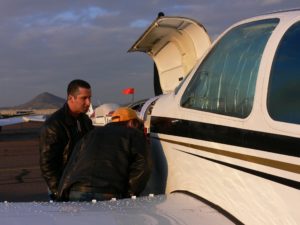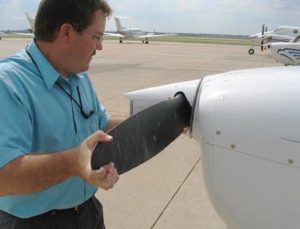Advanced Preflight After Maintenance
The General Aviation Joint Steering Committee (GAJSC) and the National Transportation
Safety Board (NTSB) have determined that a significant number of general aviation fatalities could
be avoided if pilots were to conduct more thorough preflight inspections of aircraft that have just
been returned to service. In-flight emergencies have been the direct result of maintenance
personnel who have serviced or installed systems incorrectly.

Maintenance-related problems are one of the most deadly causes of accidents in general aviation. Contributing to this is a pilot’s failure to identify maintenance discrepancies because of a lack of knowledge and improper techniques used during the preflight of the aircraft.
So What Can Pilots Do?
Conduct an Advanced Preflight that goes beyond the normal preflight checklist. Advanced preflight is a program that helps you become more aware of all the safety-related data on your aircraft, and focuses on a detailed approach to your preflight inspection, based on your aircraft’s maintenance history. While this requires some time, consider developing an additional items checklist that can be used in conjunction with the aircraft’s preflight checklist for all future preflight inspections. It is a valuable tool whether you own, rent, or borrow an aircraft.
Put Yourself in the Right Mindset
Assume that there is something wrong, even if you used the best mechanic. Mechanics typically do an excellent job,
but if you assume that all is right, you’ll miss catching any possible mistakes, worn items or improperly rigged items, or whatever else might be wrong. Always look over any part of the aircraft that has maintenance performed on it.
Use Your Senses, and a notepad, to write down anything you sense is not right. LISTEN to the airplane (not just the engine!). Do you SMELL anything abnormal? Fuel? Oil? Does it vibrate more than usual (FEEL)? Do you TASTE (or smell for that matter) any of that acrid smoke that comes with burning electrical items? Step 10 to 15 feet back from
the airplane. Does anything LOOK out of place? Be prepared to abort takeoff if something goes wrong or doesn’t feel right.

Before Your First Flight After Maintenance:
Learn all you can about the maintenance that was performed. Discuss all work that was done with the mechanic. Ask what to look out and watch for during the first flight. Do not just accept that the work was done. Ask: What was touched, repaired, or replaced, and what was accomplished?
Don’t assume the part(s) replaced are the only parts removed.
Ask what was removed and/or disconnected to facilitate the work performed. Often disassembly needs to be done to get to the inoperative part. For example:
- Upholstery / seats, tracks, floors / emergency exits
- Interior and exterior access panels especially in hard-to-see places of the aircraft
- Yokes / control cables, linkages, and surfaces
- Equipment and appliances / wires and connectors
- Hydraulic / vacuum / brake / pitot and static / fuel lines
Pay attention to trim positions.
Check for unimpeded flight control surface deflections. Make sure they go in the proper direction!
Make sure all inspection panels are secure and their fasteners are tight.
Inspect all control fasteners for missing cotter pins. Inspect locknuts, making sure the bolt or stud extends at least the full round or chamfer through the nut. Flat end bolts, studs, or screws should extend at least 1⁄32 inch through the nut. Check all visible bolts. If there’s a hole in the bolt, it requires safety wire in it. See FAA Advisory Circular AC 43.13-1B for procedures.
Check fuel tank for water, sediment, and proper fuel grade.
Use a sampler cup to drain a small quantity of fuel. Place it in front of a white (not blue) background to see what’s in the fuel. Pull out the strainer drain knob for about four seconds to clear it of water or sediment.
After an oil change, always check the engine oil level to ensure it has the proper amount of oil.
Always check your logbook and paperwork prior to flight to ensure the correct records have been entered. Check for proper log entries for the work performed and the return to service, or the aircraft isn’t legal to fly. Always ensure you have your aircraft’s correct documents (e.g., airworthiness certificate and registration) onboard.
If you see a warning tag / sign on the aircraft, or on the sign-out or status board, DO NOT FLY THE AIRCRAFT! Check with the maintenance facility prior to taking the aircraft.
Participate in, or observe your mechanic perform, an annual or 100 hour inspection.
It’s a great way to learn about your aircraft’s systems, components, and any areas prone to failure or weakness.
Resources
NTSB Safety Alert — Advanced Preflight After Maintenance: https://go.usa.gov/cK7Py; FAA’s Advanced Preflight Pamphlet: https://go.usa.gov/xVy44; “Advanced Preflight,” FAA Safety Briefing, Mar/Apr 2012: https://go.usa.gov/cK7ma
Reprinted with permission from FAA Safety Briefing magazine: https://www.faa.gov/news/safety_briefing/



